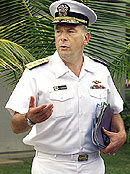 Salvage would cost $40 million Salvage would cost $40 million
 Officer admits he didn't speak up Officer admits he didn't speak up
 Waddle's boss says sub crews 'sell the Navy' Waddle's boss says sub crews 'sell the Navy'
 A Tribute to the Missing A Tribute to the Missing
 Previous stories Previous stories
By Dan Nakaso
Advertiser Staff Writer
The commander of the Pacific Fleet’s submarine force spent a tortured day at the Navy’s court of inquiry yesterday, criticizing the actions of Cmdr. Scott Waddle while declaring, "I love this commanding officer; he’s one of my best friends."
 |
| Read Adm. Al Konetzni, commander of the Pacific Fleet's submarine force, said the skipper of the USS Greeneville acted "too fast."
Associated Press |
As Day 6 of the Navy’s court of inquiry began into the fatal collision between the Greeneville and the Ehime Maru fishing vessel, Rear Adm. Al Konetzni Jr., praised and panned Waddle.
Ultimately, Konetzni pinned the blame for the accident on the skipper, whom he described as "my brother, if not my son."
Reacting to Waddle’s spending only 80 seconds peering through the Greeneville’s periscope to scan for surface ships, Konetzni looked over at Waddle and said:
"I’d like to go over there and punch him for not taking more time."
During nearly a full day of testimony, Konetzni often referred to Waddle’s career in the past tense, at one point saying, "I wanted him to become like me."
Konetzni dismissed as "red herrings" a litany of problems that occurred in the Greeneville on the day of the Feb. 9 crash:
 a broken video display monitor that would have relayed sonar information a broken video display monitor that would have relayed sonar information
 the fact that one third of the sub crew was left on shore the fact that one third of the sub crew was left on shore
 civilians at the controls of the Greeneville as it executed an "emergency blow" that sent it crashing into the Ehime Maru civilians at the controls of the Greeneville as it executed an "emergency blow" that sent it crashing into the Ehime Maru
 a fire control technician who failed to plot sonar contacts on paper. a fire control technician who failed to plot sonar contacts on paper.
‘Eight-minute period’
None of them matter in comparison to the critical final eight minutes before the collision, Konetzni said, when Waddle confused the crew by apparently taking over from the officer of the deck.
|
Today's schedule
 8 a.m.: Morning session convenes, testimony and cross examination of Capt. Robert L. Brandhuber, chief of staff, Commander Submarine Force, U.S. Pacific Fleet. Testimony from Capt. Richard L. Snead, commander Submarine Squadron One, follows. 8 a.m.: Morning session convenes, testimony and cross examination of Capt. Robert L. Brandhuber, chief of staff, Commander Submarine Force, U.S. Pacific Fleet. Testimony from Capt. Richard L. Snead, commander Submarine Squadron One, follows.
 1 p.m.: Afternoon session convenes. Testimonies and cross examinations to continue. 1 p.m.: Afternoon session convenes. Testimonies and cross examinations to continue.
 4:30 p.m.: Afternoon session adjourns. 4:30 p.m.: Afternoon session adjourns.
|
"For an eight-minute period he either consciously or subconsciously took charge of that ship and acted like he knew everything," Konetzni said. ".... And the fellas followed for an eight-minute period and it ended up in a disastrous mode.
"This event would not have occurred if the skipper had taken time in going to periscope depth and he had taken his time with his look," Konetzni said. "... I don’t call it criminal neglect. But it was too fast, damn it."
The Greeneville had poorly tracked a sonar contact that turned out to be the Ehime Maru. And Waddle failed to spend the usual three minutes to search the surface by periscope, according to previous testimony in the court of inquiry under way at Pearl Harbor.
In peacetime operations where safety overrides the need for stealth, Konetzni said, "You better get as much pole out there as you can. ... I would put as much periscope out of the water as I need to."
Asked whether the court of inquiry should recommend improving the search-and-rescue capabilities of submarines, Konetzni flatly said, "It’s a waste of time; it’s a waste of money."
Earlier during the proceedings, the preliminary investigator recommended that the three admirals who are presiding consider urging Navy officials to study improving submarines’ search-and-rescue efforts.
Rescue capabilities
The lack of a rescue effort by the Greeneville after the crash angered people in Japan and helped strain U.S.-Japan relations.
But Konetzni said that "a submarine is made for war. Anything you do to upgrade the search-and-rescue capabilities will take away from what it does. ... It will take the Navy down an area that might be politically correct. But it’s going to add little."
He told the president of the court of inquiry, Vice Adm. John Nathman, to "stand tall ... and realize that is the capability of a U.S. submarine."
Nathman replied, "I think it’s appropriate for us to suggest that this should be reviewed."
The counsel for the court, Capt. Bruce E. MacDonald, also announced yesterday that two Greeneville crewman — the sonar room supervisor and fire control technician of the watch — were granted legal counsel.
Rear Adm. Charles Griffiths, Jr., the preliminary investigator into the crash, testified earlier that an unqualified sonar technician, Stuart Ray Rhodes, was not properly supervised.
The sailor who was supposed to supervise the technician, Roberto Reyes, instead was assigned to lead civilian visitors on a ship tour.
Griffiths also criticized the fire control technician of the watch, Patrick Thomas Seacrest, for not speaking out about the sonar contact that turned out to be the Ehime Maru.
[back to top] |

